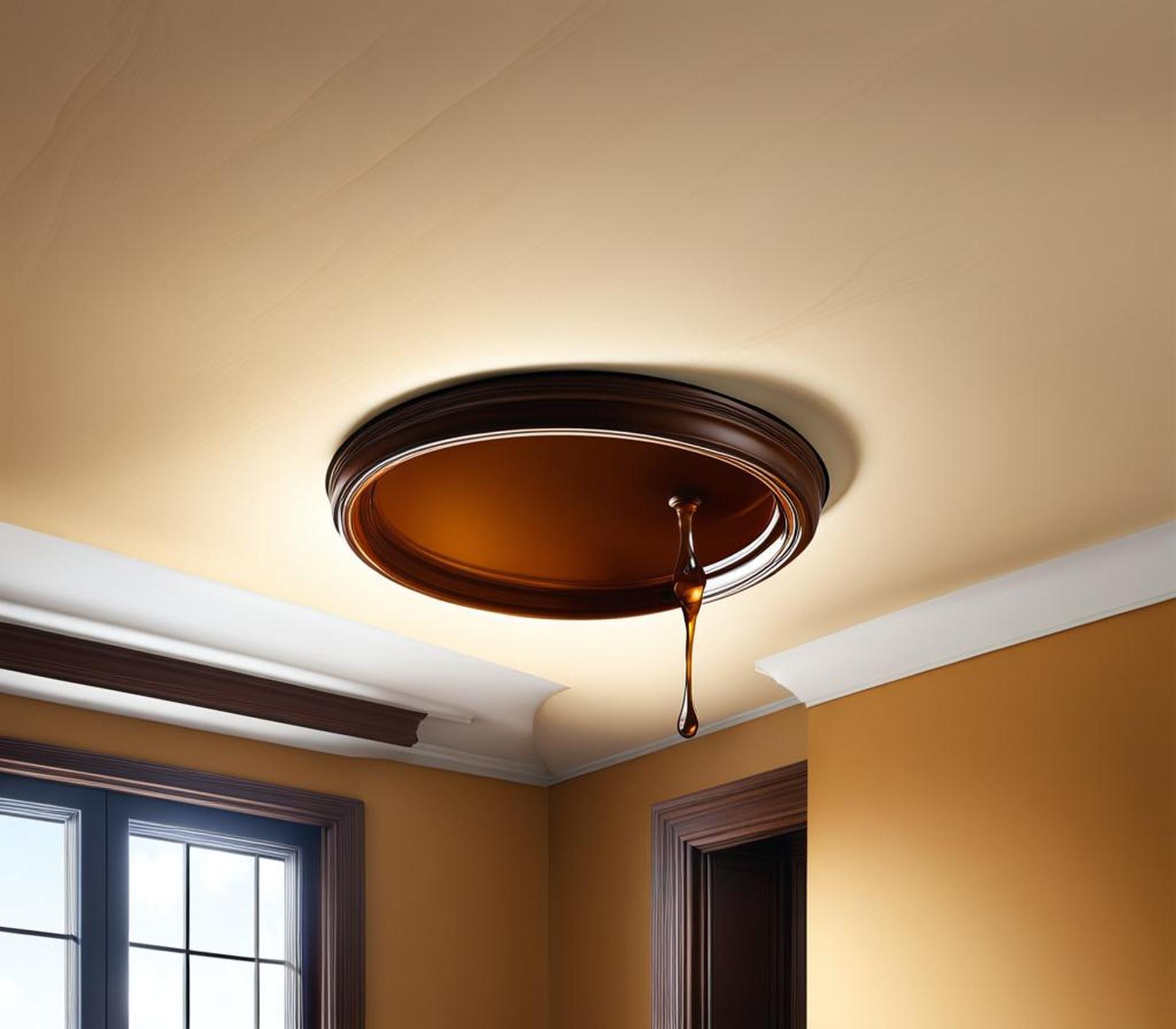After a heavy rainstorm, the last thing you want to see is brownish water dripping from the ceiling. That discolored water may indicate concealed moisture damage in the attic or walls. Left unchecked, brown ceiling stains can develop into peeling paint, soggy drywall, or even mushrooming mold colonies. Read on to decode common causes of brown ceiling leaks and how to limit the damage.
Is That Brown Water Dripping from Your Ceiling?
Seeing brown liquid seeping through the ceiling can be alarming. Our first instinct may be to grab a bucket and towel to catch the drips. However, the emergence of brownish water or stains warrant further investigation into what’s happening in the attic or roof.
While clear water leaks signal routine roof damage, rusty brown drips may indicate more extensive deterioration that requires prompt repair. The color likely comes from tannins leaching out of water-logged wood. But we can’t rule out the stain camouflaging contamination from critters or fungi thriving out of sight.
Brown Ceiling Stains Usually Result From Tannins in Wood
The chestnut hue of brown ceiling leaks comes from tannins innate within wood. Tannins are natural compounds that resist insect attack and accelerate decay. When dampness hits wood framing, tannins solubilize, staining any surface they drip upon.
Once tannins leach out and bond to ceiling paint or drywall paper, stains persist even after we remedy the moisture source. The sunken area feels dry but retains that telltale brown discoloration.

Key Causes of Brown Ceiling Water Stains
- Roof leaks from damaged shingles, poor flashings or neglected maintenance
- Gutter overflows from clogged debris or seams splitting
- Leaking pipes or toilet tanks saturating ceiling cavities
- Poor attic insulation leading to condensation drips
Don’t Assume It’s Just Harmless Rusty Water
When we spot brownish water trickling from above, it’s reasonable to assume rust or minerals in pipes or roofing materials have tinted the drips. However, brown ceiling stains seldom stem from ferrous components corroding within roof assemblies or supply lines.
For true rust stains, iron components must oxidize when exposed to moisture. Occasionally, fasteners on tin roofs or cast iron drain pipes corrode. But wood tannins remain the predominant source of brown ceiling leaks after storms or snowmelt.
Why Rain Triggers Brown Ceiling Stain Leaks
When raindrops pelt a vulnerable roof, water seeps through compromised membranes or flashings, dripping into the attic. As leakage moisture permeates wood trusses, sheathing or framing, tannins dissolve and escape.
Ongoing exposure accelerates decay fungi which further liquefy cellulose and liberate more discoloring tannic acid. Insufficient roof drainage causes pooling that Ruins insulation or plasterboard ceilings underneath.
Roofing Materials and Systems Most Vulnerable
- Damaged, missing or improperly installed shingles allowing water infiltration.
- Deteriorated flashing around chimneys no longer sealing joints.
- Poorly sealed skylights leaking at frames or protruding fasteners.
- Gaps around vents, ductwork or pipes enabling water intrusion.
Pinpointing the Source of Brown Water Leaks
Tracking down the origin of brown ceiling stains takes systematic detective work. The location and shape of water marks provide clues whether the leak stems from roof or plumbing failures.
Round stains suggest moisture dripping through localized holes. Irregular brown splotches indicate a broader seepage source like deteriorated roof valleys or degraded window caulking.
Use Stain Patterns To Trace Leaks
- Central ceiling stains likely stem from roof membrane gaps or flashing failures around chimneys.
- Perimeter stains may signal leaks at skylights, vents or neglected wall caulking.
- Stains under bathrooms or supply lines hint at pipe joints, toilet seals or trap leaks.
Health Hazards from Brown Water Drips
While tannin-tinted water seems harmless, the moisture fueling discoloration breeds a host of respiratory and safety hazards. Leaks provide the ideal dark, damp environment for mold infestations and wood decay.
As mold colonizes unseen cavities, spores disperse through vents and cracks. Inhaling these microscopic allergens triggers sinus congestion, wheezing, headaches and fatigue.
Meanwhile, deteriorating framing suffers strength loss as fungi feast on cellulose. Eventually the sodden substrate fails, endangering occupants below.
Act Fast to Limit Brown Water Ceiling Damage
Upon noticing brown stains, immediately investigate for attic moisture. Place buckets beneath drips to minimize harm. Reduce indoor humidity levels. Report roof leakage to your building owner or property manager.
Don’t cover stains with plastic sheeting as it traps moisture. If large areas appear at risk of collapse, vacate the room until framing reinforcements are installed.
Professional Roof Inspections Critical After Storms
Following extreme weather, enlist an experienced roofer to scrutinize your entire roof system. They should methodically survey every component and seam for deterioration and leakage.
professionals also perform diagnostic flood tests using garden hoses to simulate rainstorm conditions. Electromagnetic scanners help pinpoint internal moisture issues needing repair.
How Roofing Contractors Repair Brown Water Leak Damage
Remedying brown ceiling drips involves extensive repairs to damaged roofing, flashings and drainage mechanisms. After troubleshooting leaks, crews clear debris from gutters and drainage paths. This is followed by replacing worn shingles, deteriorated flashings and outdated caulking.
For severely degraded roofing, complete tear-offs and reinstallation provides lasting waterproofing. Proactive maintenance like sealant touch-ups, pipe boot replacements and gutter screen installation prevents recurrence.
Restoring Brown-Stained Ceilings after Leak Repairs
Even after halting the water source, unsightly brown splotches, warping and mold may linger. Stain-blocking primers containing shellac alcohol compounds help block pigments from bleeding through paint. Replace extensively water-damaged sections of sheetrock and insulation.
Applying mold inhibitor solution and drying equipment accelerates cavity moisture reduction. Fresh coats of interior ceiling paint finish the facelift while monitoring for leaks guides next steps.
While storms batter roofs unpredictably, proactive maintenance limits damage. Semi-annual professional roof inspections detect minor issues before they jeopardize waterproofing. Keep trees and ladder away from the roofline.
Installing gutter guards avoids debris-clogging while screen attic vents maintain airflow. Monitoring indoor humidity deters condensation drips. Develop water stains early to avoid future leaks staining your ceiling brown.
